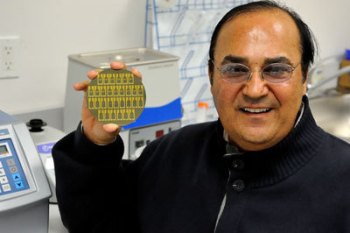Apr 20 2013
Pharmaco-Kinesis Corporation (PKC), developer of a pre-commercialized smart implantable pump for localized cancer-fighting drug delivery, today announced its first commercialized offering, the first-generation Nano-Impedance Biosensor (NIB).
 PKC CEO Frank Adell displays VEGF Biosensor wafer (Photo: Business Wire)
PKC CEO Frank Adell displays VEGF Biosensor wafer (Photo: Business Wire)
The NIB detects VEGF-165 (vascular endothelial growth factor), a general biomarker correlating to the presence of a cancerous tumor in the body. VEGF-165 is documented to play a significant role in angiogenesis—the fundamental process in tumor growth and metastasis—for various types of cancers. The NIB is an integrated part of the company’s Metronomic Biofeedback Pump (MBP) drug-delivery system and measures the VEGF-165 marker as an indicator of patient disease status and effectiveness of therapy following the administration of treatment medications.
“This is a major milestone in the detection and treatment of cancerous tumors,” said PKC Chief Executive Officer Frank Adell. “The impact will be enormous, as this proprietary sensor technology paves the way for implanted biosensors that can detect disease in the body in its earliest stage.”
About the size of an aspirin, the NIB offers sensitivity to detect VEGF at levels as low as 1 to 10 protein molecules in the billions of molecules present in 1 mL of blood or cerebral fluid, which is unlike any other VEGF-detecting mechanism available today. Adell explained that the company foresees that PKC next-generation products using NIB technology could become available for over-the-counter consumer purchase at local pharmacies and be used to measure biomarkers for cancer and other chronic illnesses, much in the same way blood pressure or glucose levels are measured today. Data from readings could then be sent wirelessly and automatically via internet or mobile device to a physician or hospital for evaluation.
“Our vision is to enable people to find the presence of cancer in their bodies as soon as the first cancer cell appears, substantially boosting the success rate of cure, which is directly proportional to early detection,” said Adell. “This represents a true paradigm shift from the ‘sick first, and then treat’ mindset, moving us in a direction wherein we can provide earliest detection of disease and offer lower-impact treatments that will improve patient outcomes, put more control in the hands of physicians and patients, and lessen the burden on a healthcare system that cost $2.7 trillion in 2011.”
Source: http://www.pharmaco-kinesis.com/